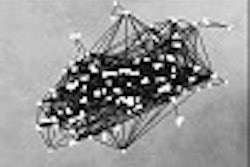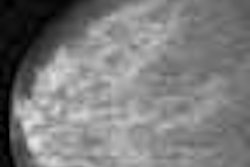Computed radiography for breast imaging offers a greater level of lesion conspicuity than screen-film mammography, and may be of particular value in dense breasts. Dr. Jeffrey Quam from the Mayo Clinic shared the results of his group’s investigation at the 2003 RSNA conference in Chicago. At the time of the study, Quam was based at the clinic in Rochester, MN; he is now at the Scottsdale, AZ facility.
For this study, patients were enrolled at the Mayo Clinic and at the Iris Cantor Center for Breast Imaging, University of California, Los Angeles (Dr. Lawrence Bassett was a co-author on the paper). Patients underwent computed radiography for mammography (CRM) on several different units, outfitted with a FCR 5000MA from Fuji Medical Systems USA. The University of Chicago served as the core reading site.
"Fuji has been doing (computed radiography) for almost 20 years, but the device that we were using for CRM is an investigational tool. The data that we acquired here was part of the clinical arm for FDA approval," Quam said. "The purpose of our study was to look at the gold standard of screen-film mammography (SFM) and compare it with this new investigational device... in addition, while we were looking at the cases, we recognized another trend, and it looks like, in fact, that there might be some value in dense breasts as an additional opportunity for this new device."
There were 218 women enrolled at the image acquisition sites over a one-year period. They underwent SFM and, if enrolled in the study, CRM, the latter with dual-side reading, 50-micron pixel size, and processing for microcalcification enhancement.
"In general, when the patients would arrive for their already-scheduled SFM, if during that mammographic workup we recognized that there was a focal mammographic finding that was suspicious and we wanted to biopsy, we then asked the patients if they wanted to enroll in the study," Quam explained. "If they did want to enroll, all of the images that were taken with SFM were duplicated with CRM, with four standard images and, in addition, any specific special views were duplicated."
The four standard views from SFM and CRM were evaluated side by side. If a focal mammographic abnormality was present, the conspicuity of its features was rated, for each modality, using a 12-point Likert scale (zero equaled no finding identifiable; 11 indicating highly conspicuous).
"One thing that we made certain of was that the difference in conspicuity was not based on a difference in positioning or a difference in compression. We were really comparing apples to apples," Quam said.
According to the results, in 218 patients there were 174 abnormalities that the group deemed comparable. Of those 174 findings, 55 were cancers, and 119 were benign. The mean conspicuity ratings for SFM in all 174 cases was 8.5; the mean ratings for CRM was 8.8.
"Although that value wasn’t great, it certainly was statistically significant," Quam said. "There was an increase in conspicuity using CRM of 0.3 units."
About 37% of the patients had dense breast tissue. In this group, the mean conspicuity ratings for SFM was 7.9 and 8.6 for CRM (p=0.0031).
"If we pare these numbers down to the 63 patients with focal findings in dense breasts, you can see that the difference is even greater, with 8.1 conspicuity (ratings) in SFM and 8.7 with CRM," Quam said. "We then pulled out just the patients that have cancers. The mean conspicuity (rating) was 8.9 SFM and CRM, 9.2."
Sixty patients had tissue-proven cancer. Out of this group, one had a three-point difference favoring SFM (mass with calcifications). In comparison, 11 patients had a three- to nine-point difference in conspicuity in favor of CRM (seven masses; four calcifications).
Finally, three tissue-proven findings (a malignant mass, a benign mass, and one benign calcification) were seen on CRM but not SFM. A single tissue-proven benign mass was seen on SFM only.
Although his group did try to minimize differences in positioning, the latter most likely accounted for the masses that were seen with one modality and not the other.
"There's a lot of subjectivity looking at these things because the findings are 'soft,'" Quam told AuntMinnie.com. "One of the things that have been shown in these studies is that, a lot of times, the slight differences are because of positioning, even though you try to do your best to not allow that. Breasts can turn a little from one view to another, and, often, that is the case. That may have been the case in these circumstances also."
Despite these differences, CRM still proved to be the more sensitive exam, Quam stressed. "Unquestionably, CRM is capable of looking through dense parenchyma with a little bit greater accuracy than SFM," he said.
In addition to greater lesion conspicuity in dense breasts, another advantage of CRM is that it is compatible with several different mammography units, Quam added, and does not require a forklift to install.
In spring of 2003, Quam and his co-investigators in Chicago performed a comparison of soft-copy versus hard-copy review with very promising results. "The bottom line is that having soft-copy capability is more accurate than having just a single hard-copy," he said.
By Shalmali PalAuntMinnie.com staff writer
April 9, 2004
Related Reading
Austrian study finds FFDM, CR equivalent for breast cancer detection, February 23, 2004
Fujifilm highlights CR, PACS introductions, December 4, 2003
Flat-panel unit beats CR for digital mammography, March 7, 2003
Copyright © 2004 AuntMinnie.com



















